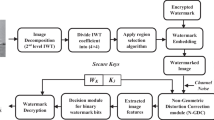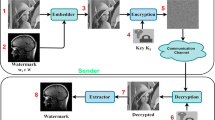Abstract
H.264/AVC-based products have grown tremendously in social networks; issues of content-based authentication become increasingly important. This paper presents a blind fragile watermarking scheme for content-based H.264/AVC authentication, which enjoys high sensitivity to typical video attacks. A spatiotemporal analysis is exploited to guarantee a minimum impact on perceptual quality and bit-rate increment. The watermark features are extracted from intra/inter prediction modes of intra/inter macroblocks, constituting the content-based Message Authentication Code (MAC) which is embedded/extracted in a Group-of-Pictures GOP-based fashion utilizing the syntactic elements of the Network Application Layer (NAL) units from the compressed bitstream. It’s unnecessary to fully decode a compressed bitstream before the embedding or detection processes. A content-based key is generated to control fragile watermark generation, embedding, extraction, and verification algorithms. Additionally, fragility is ensured by selecting the last nonzero quantized ac residuals for watermark embedding. The embedded watermark can be detected and verified by means of partially decoding intra/inter prediction modes from syntactic elements of the bitstream without the prior knowledge of the original video or complete decoding. Experiment results demonstrate that the performance of the proposed scheme is excellent in terms of bit-rate and perceptual quality. Furthermore, various types of content-preserving and/or content-changing attacks can be detected efficiently.













Similar content being viewed by others
References
(2003) ISO/IEC 14496–10 and ITU-T Rec. H.264, Advanced video coding
Ahmad I, Wei X, Sun Y, Zhang Y (2005) Video transcoding: an overview of various techniques and research issues. IEEE Trans Multimed 7(5):793–804
Aho A, Sethi R, Ullman J (1986) Compilers: principles, techniques, and tools. Addison-Wesley, pp. 434–438
American National Standard for Telecommunications-Digital Transport of One-Way Video Signals-Parameters for Objective Performance Assessment, Standard T1.801.03-003, Jul. 2003, vol. ANSI
Cappellini V, Bartolini F, Caldelli R, De Rosa A, Piva A, Bami A (2001) “Robust frame-based watermarking for digital video,” Proceedings 12th International Workshop on Database and Expert Systems Applications, pp. 825–829
Chen B, Wornell GW (2001) Quantization index modulation: a class of provably good methods for digital watermarking and information embedding. IEEE Trans Inf Theory 47(4):1423–1443
Cox I, Kilian J, Leighton FT, Shamoon T (1997) Secure spread spectrum watermarking for multimedia. IEEE Trans Image Process 6(12):1673–1687
Furht B, Marques O (2003) Handbook of video databases: design and applications. CRC Press, Boca Raton
Golikeri A, Nasiopoulos P, Wang ZJ (2007) Robust digital video watermarking scheme for H.264 advanced video coding standard. J Electr Imaging 16(4):043008
Gonzalez RC, Woods RE (2008) Digital image processing, 3rd edn. Prentice-Hall, Englewood Cliffs
Horowitz M, Joch A, Kossentini F, Hallapuro A (2003) H.264/AVC baseline profile decoder complexity analysis. IEEE Trans Circ Syst Video Technol 13(7):704–716
Hu Y, Zhang CT, Su YT (2007) “Information hiding based on intra prediction modes for H.264/AVC,” IEEE International Conference on Multimedia and Expo (ICME 2007), Beijing, China, pp. 1231–1234
Huang SC, Kuo SY (2008) Optimization of hybridized error concealment for H.264. IEEE Trans Broadcast 54(3):499–516
Kapotas SK, Skodras AN (2009) Real time data hiding by exploiting the IPCM macroblocks in H.264/AVC streams. J Real-Time Image Proc 4(1):33–41
Kim SM, Kim SB, Hong Y, Won CS (2007) “Data hiding on H.264/AVC compressed video,” International Conference on Image Analysis and Recognition (ICIAR 2007), Montreal, Canada, LNCS, vol. 4633, 2007, pp. 698–707
Kim T, Park K, Hong Y (2012) Video watermarking technique for H.264/AVC. Opt Eng 51(4)
Koz A, Alatan AA (2008) Oblivious spatio-temporal watermarking of digital video by exploiting the human visual system. IEEE Trans Circ Syst Video Technol 18(3):326–337
Lin ET (2005) Video and image watermark synchronization Purdue University
Lin WH, Horng SJ, Kao TW, Chen RJ, Chen YH, Lee CL, Terano T (2009) Image copyright protection with forward error correction. Expert Syst Appl 36(9):11888–11894
Lin WH, Horng SJ, Kao TW, Fan P, Lee CL, Pan Y (2008) An efficient watermarking method based on significant difference of wavelet coefficient quantization. IEEE Trans Multimed 10(5):746–757
Lin WH, Wang YR, Horng SJ, Pan Y (2009) A blind watermarking method using maximum wavelet coefficient quantization. Expert Syst Appl 36(9):11509–11516
Liu CH, Chen OTC (2008) “Data hiding in inter and intra prediction modes of H.264/AVC,” IEEE International Symposium on Circuits and Systems (ISCAS 2008), Seattle, Washington, USA, pp. 3025–3028
Mansouri A, Aznaveh A, Torkamani-Azar F, Kurugollu F (2010) A low complexity video watermarking in H.264 compressed domain. IEEE Trans Inf Forensic Secur 5(4):649–657
Noorkami M, Mersereau RM (2007) A framework for robust watermarking of H.264-encoded video with controllable detection performance. IEEE Trans Inf Forensic Secur 2(1):14–23
Noorkami M, Mersereau RM (2008) Digital video watermarking in P-frames with controlled video bit-rate increase. IEEE Trans Inf Forensic Secur 3(3):441–455
Proefrock D, Richter H, Schlauweg M, Mueller E (2005) H.264/AVC video authentication using skipped macroblocks for an erasable watermark. Proc SPIE 5960:1480–1489
Qiu G, Marziliano P, Ho ATS, He D, Sun Q (2006) “A hybrid watermarking scheme for H.264/AVC video,” Proceedings of the 17th International Conference on Pattern Recognition (ICPR 2004), vol. 4, Aug., pp. 2353–2356
Reference Software JM, J.V.T., version 14.0, http://iphome.hhi.de/suehring/tml/download/
Richardson IE (2004) H.264 and MPEG-4 video compression. Wiley
Saadi K, Bouridane A, Guessoum A (2009) “Combined fragile watermark and digital signature for H.264/AVC video authentication,” EUSIPCO 2009, Scotland, Glasgow
Wang Z, Bovik AC, Sheikh HR, Simoncell EP (2004) Image quality assessment: from error visibility to structural similarity. IEEE Trans Image Process 13(4):600–612
Wang CC, Hsu YC (2010) Fragile watermarking scheme for H.264 video authentication. Opt Eng 49(2)
Wolfgang RB, Podilchuk CI, Delp EJ (1999) Perceptual watermarks for digital images and video. Proc SPIE 3567:40–51, San Jose CA
Xiaopeng F, Yan L, Wen G (2003) “A novel coefficient scanning scheme for directional spatial prediction-based image compression,” Proceedings of the International Conference on Multimedia and Expo, (ICME’03), Jul., pp. II-557–560
Xu D, Wang R (2011) Watermarking in H.264/AVC compressed domain using Exp-Golomb code words mapping. Opt Eng 50(9):267–279
Xu D, Wang R, Wang J (2011) A novel watermarking scheme for H.264/AVC video authentication. Signal Process Image Commun 26(6)
Yang G, Li J, He Y, Kang Z (2011) An information hiding algorithm based on intra-prediction modes and matrix coding for H.264/AVC video stream. Int J Electron Commun 65(4):331–337
Zhu BB, Swanson MD, Tewfik AH (2004) When seeing isn’t believing. IEEE Signal Process Mag 21(2):40–49
Acknowledgments
This work was supported in part by the National Science Council under contract number NSC101-2221-E-011-063-MY3 and it was also partially supported by the 111 Project under the grant No. 111-2-14, One Hundred Talents Program 2012, Sichuan Province. M. E. Farfoura is currently a system analyst with the Information Technology Center- Royal Scientific Society, Jordan-Amman. The work of X. Wang was supported by the National Science Foundation of China under Grants 60902023 and 61171096, as well as by the Fundamental Research Funds for the Central Universities under the Grant SWJTU12CX093.
Author information
Authors and Affiliations
Corresponding author
Rights and permissions
About this article
Cite this article
Horng, SJ., Farfoura, M.E., Fan, P. et al. A low cost fragile watermarking scheme in H.264/AVC compressed domain. Multimed Tools Appl 72, 2469–2495 (2014). https://doi.org/10.1007/s11042-013-1561-2
Published:
Issue Date:
DOI: https://doi.org/10.1007/s11042-013-1561-2




